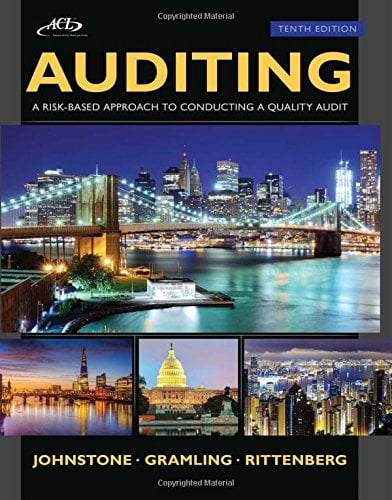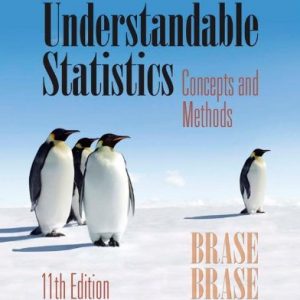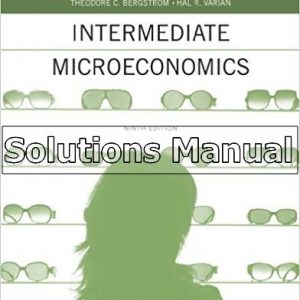Instant download Auditing A Risk Based-Approach to Conducting a Quality Audit Johnstone 10th Edition Solutions Manual pdf docx epub after payment.

Product details:
- ISBN-10 : 1305080572
- ISBN-13 : 978-1305080577
- Author: Larry E. Rittenberg; Karla M. Zehms
As today’s auditing environment continues to change in dramatic ways, those entering the profession must be prepared to handle a high standard of responsibility. You can prepare with the help of AUDITING: RISK-BASED APPROACH TO CONDUCTING QUALITY AUDITS, 10E. AUDITING reflects the latest clarified auditing standards and the newest PCAOB standards, while discussing the COSO’s Internal Control–Integrated Framework and the AICPA’s recently issued new audit sampling guidance. You’ll find the most recent professional developments with a new integrated emphasis on the latest fraud risks and ethical challenges throughout the book. New end-of-chapter problems as well as new cases provide valuable hands-on experience.
Table Of Contents:
- Ch 1: Auditing: Integral to the Economy
- Overview of the External Auditing Profession
- Audit Quality
- Achieving Audit Quality and Minimizing Lawsuits
- Client Acceptance and Continuance Decisions
- Summary and Next Steps
- Ch 2: The Auditor’s Responsibilities Regarding Fraud and Mechanisms to Address Fraud: Regulation and
- Fraud Defined
- The Fraud Triangle
- Recent History of Fraudulent Financial Reporting
- An Overview of the Auditor’s Fraud-Related Responsibilities and Users’ Expectations
- The Sarbanes-Oxley Act of 2002 as a Regulatory Response to Fraud
- The Post Sarbanes-Oxley World: A Time of Improved Corporate Governance
- Summary and Next Steps
- Ch 3: Internal Control over Financial Reporting: Responsibilities of Management and the External Aud
- Importance of Internal Control over Financial Reporting
- Defining Internal Control
- Components and Principles of Internal Control
- Management’s Responsibilities Related to Internal Control over Financial Reporting
- Importance of Internal Control to the External Audit
- Summary and Next Steps
- Ch 4: Professional Liability, Auditor Judgment Frameworks, and Professional Responsibilities
- The Legal Environment and the Effects of Lawsuits on Audit Firms
- Applicable Laws and Causes of Legal Action
- Auditor Liability under Contract Law, Common Law, and Statutory Law
- Auditor Liability under Statutory Law
- A Framework for Professional Decision Making
- A Framework for Ethical Decision Making
- Guidance on Professional Responsibilities and the Impact on Auditors’ Decisions
- Summary and Next Steps
- Ch 5: Professional Auditing Standards and the Audit Opinion Formulation Process
- Professional Auditing Standards
- The Audit Opinion Formulation Process
- Summary and Next Steps
- Ch 6: A Framework for Audit Evidence
- Obtaining Sufficient Appropriate Audit Evidence
- Appropriateness of Audit Evidence
- Type and Timing of Audit Procedures
- Sufficiency of Audit Evidence
- Additional Evidence Considerations
- Documenting Audit Evidence
- Summary and Next Steps
- Ch 7: Planning the Audit: Identifying and Responding to the Risks of Material Misstatement
- The Concept of Materiality
- Identifying and Assessing Risks of Material Misstatement
- Responding to Identified Risks of Material Misstatement
- Summary and Next Steps
- Ch 8: Specialized Audit Tools: Sampling and Generalized Audit Software
- Overview of Sampling and GAS as Tools for Gathering Audit Evidence
- Objectives of Sampling and Risks Associated with Sampling
- Nonstatistical and Statistical Sampling
- Attributes Sampling
- Using Sampling to Gather Evidence about Misstatements in Account Balances and Associated Assertions
- Using GAS to Obtain Evidence
- Summary and Next Steps
- Ch 9: Auditing the Revenue Cycle
- Significant Accounts, Disclosures, and Relevant Assertions
- Performing Risk Assessment Procedures in the Revenue Cycle
- Obtaining Evidence about Internal Control Operating Effectiveness in the Revenue Cycle
- Obtaining Substantive Evidence about Accounts, Disclosures, and Assertions in the Revenue Cycle
- Summary and Next Steps
- Ch 10: Auditing Cash and Marketable Securities
- Significant Accounts, Disclosures, and Relevant Assertions
- Performing Risk Assessment Procedures for Cash Accounts
- Obtaining Evidence about Internal Control Operating Effectiveness for Cash
- Obtaining Substantive Evidence about Cash Accounts, Disclosures, and Assertions
- Auditing Marketable Securities
- Summary and Next Steps
People also search:
Auditing A Risk Based-Approach to Conducting a Quality Audit Johnstone 10th Edition
|
auditing a risk-based approach to conducting a quality audit |





